Comprehensive Analysis of Infrastructure Management Assignment
VerifiedAdded on 2021/04/24
|6
|1702
|74
Homework Assignment
AI Summary
This document provides a detailed solution to an infrastructure management assignment, addressing key concepts and practical applications. The assignment begins with defining and explaining terminologies such as Electronic Records Management, BI and Analytics, Data and Text Mining, Big data analytics, Enterprise architecture, Management information systems, Data life cycle and data principles, and Cloud Computing. The solution then explores how data and text mining create business value through outlier detection, association rule learning, cluster analysis, regression analysis, and classification analysis. It addresses the problems associated with cloud computing, providing examples of security and data loss issues along with potential solutions. The document analyzes case studies from the textbook, including 'Data Quality Determines Systems Success and Failure' and 'Coca-Cola Manages at the Point That Makes a Difference,' answering specific questions to demonstrate a deep understanding of the course material. The analysis includes the importance of data governance, real-time POS data processing, customer experience creation, and the strategic benefit of the Black Book model.
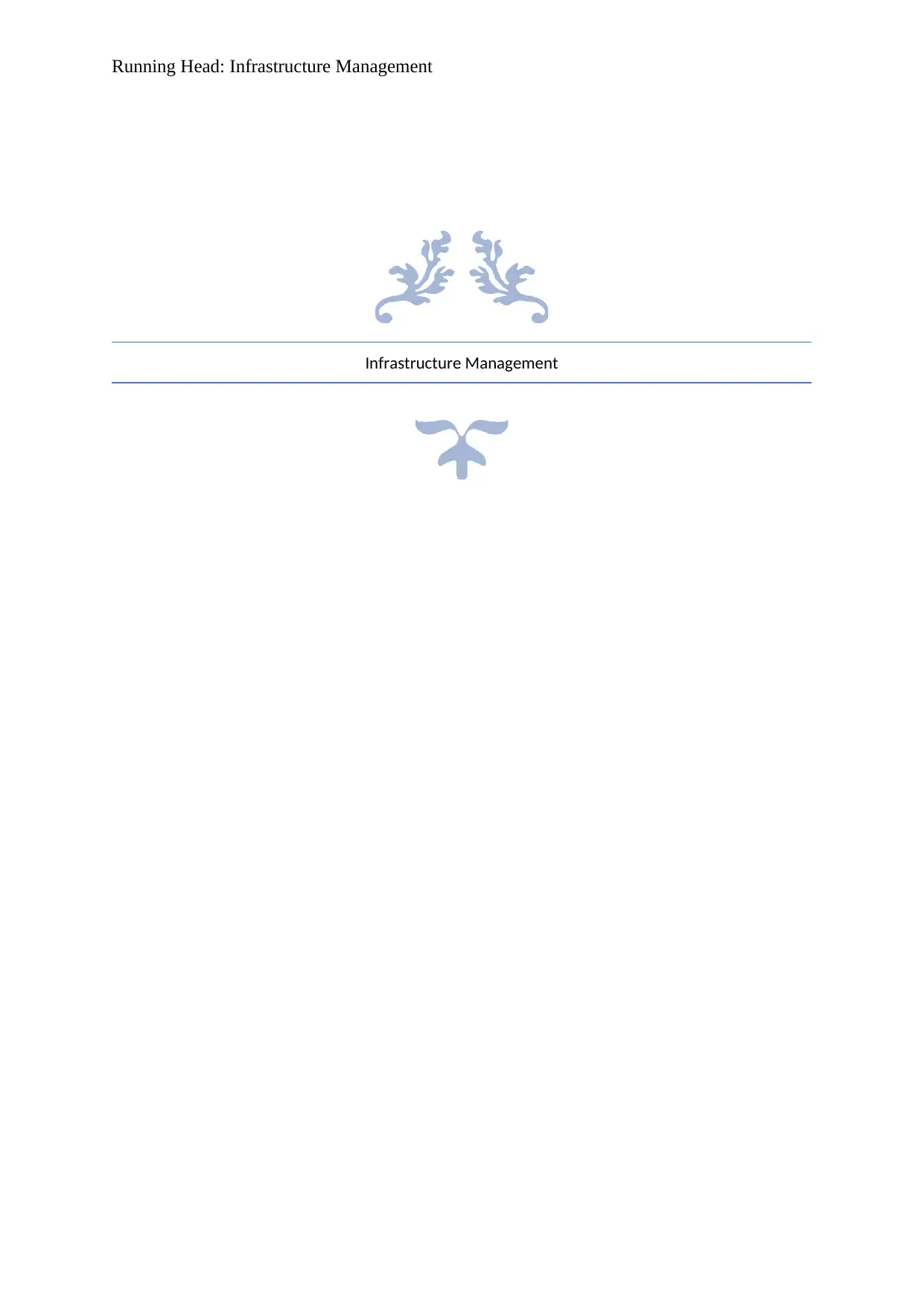
Running Head: Infrastructure Management
Infrastructure Management
Infrastructure Management
Paraphrase This Document
Need a fresh take? Get an instant paraphrase of this document with our AI Paraphraser
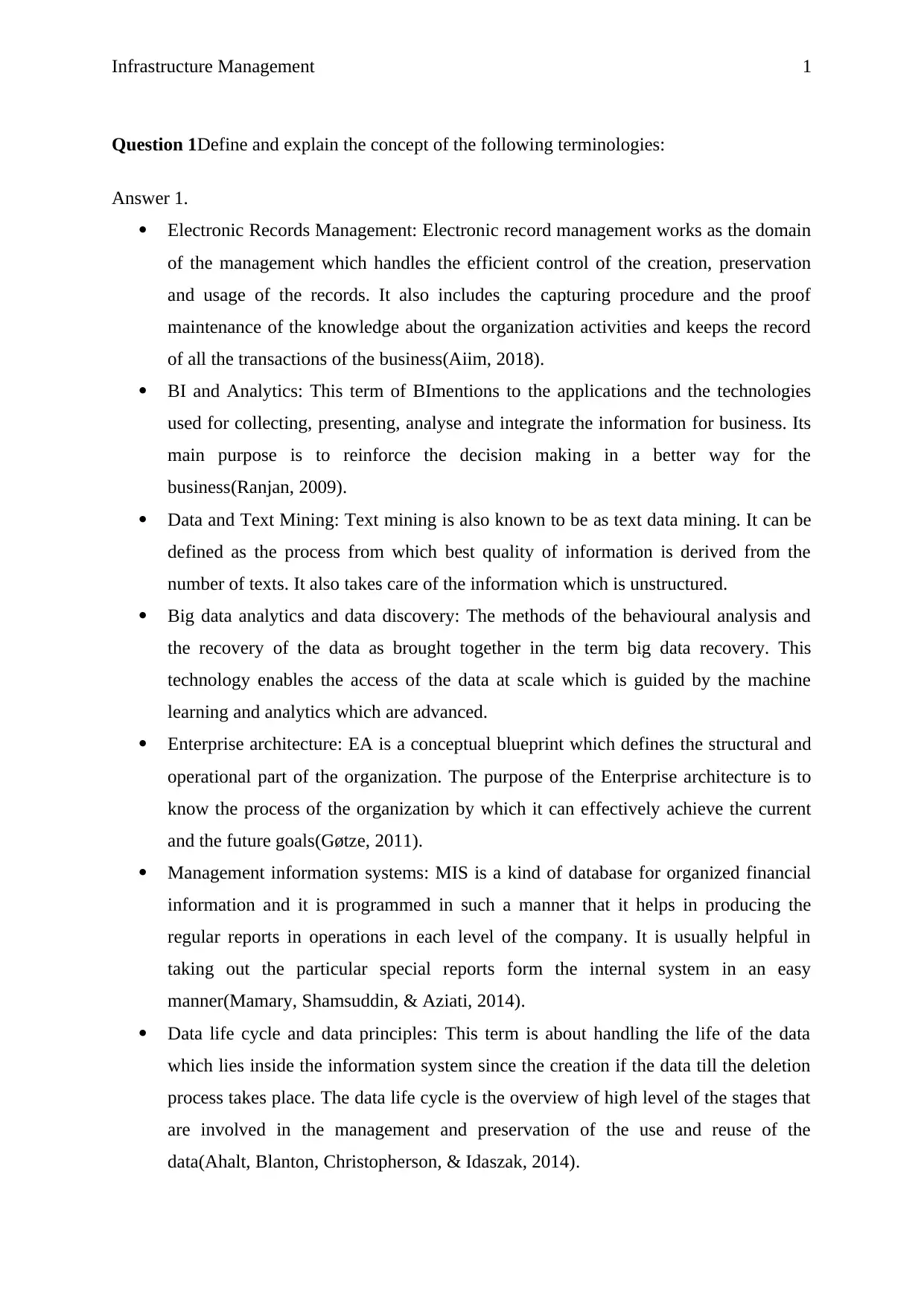
Infrastructure Management
Question 1Define and explain the concept of the following terminologies:
Answer 1.
Electronic Records Management: Electronic record management works as the domain
of the management which handles the efficient control of the creation, preservation
and usage of the records. It also includes the capturing procedure and the proof
maintenance of the knowledge about the organization activities and keeps the record
of all the transactions of the business(Aiim, 2018).
BI and Analytics: This term of BImentions to the applications and the technologies
used for collecting, presenting, analyse and integrate the information for business. Its
main purpose is to reinforce the decision making in a better way for the
business(Ranjan, 2009).
Data and Text Mining: Text mining is also known to be as text data mining. It can be
defined as the process from which best quality of information is derived from the
number of texts. It also takes care of the information which is unstructured.
Big data analytics and data discovery: The methods of the behavioural analysis and
the recovery of the data as brought together in the term big data recovery. This
technology enables the access of the data at scale which is guided by the machine
learning and analytics which are advanced.
Enterprise architecture: EA is a conceptual blueprint which defines the structural and
operational part of the organization. The purpose of the Enterprise architecture is to
know the process of the organization by which it can effectively achieve the current
and the future goals(Gøtze, 2011).
Management information systems: MIS is a kind of database for organized financial
information and it is programmed in such a manner that it helps in producing the
regular reports in operations in each level of the company. It is usually helpful in
taking out the particular special reports form the internal system in an easy
manner(Mamary, Shamsuddin, & Aziati, 2014).
Data life cycle and data principles: This term is about handling the life of the data
which lies inside the information system since the creation if the data till the deletion
process takes place. The data life cycle is the overview of high level of the stages that
are involved in the management and preservation of the use and reuse of the
data(Ahalt, Blanton, Christopherson, & Idaszak, 2014).
1
Question 1Define and explain the concept of the following terminologies:
Answer 1.
Electronic Records Management: Electronic record management works as the domain
of the management which handles the efficient control of the creation, preservation
and usage of the records. It also includes the capturing procedure and the proof
maintenance of the knowledge about the organization activities and keeps the record
of all the transactions of the business(Aiim, 2018).
BI and Analytics: This term of BImentions to the applications and the technologies
used for collecting, presenting, analyse and integrate the information for business. Its
main purpose is to reinforce the decision making in a better way for the
business(Ranjan, 2009).
Data and Text Mining: Text mining is also known to be as text data mining. It can be
defined as the process from which best quality of information is derived from the
number of texts. It also takes care of the information which is unstructured.
Big data analytics and data discovery: The methods of the behavioural analysis and
the recovery of the data as brought together in the term big data recovery. This
technology enables the access of the data at scale which is guided by the machine
learning and analytics which are advanced.
Enterprise architecture: EA is a conceptual blueprint which defines the structural and
operational part of the organization. The purpose of the Enterprise architecture is to
know the process of the organization by which it can effectively achieve the current
and the future goals(Gøtze, 2011).
Management information systems: MIS is a kind of database for organized financial
information and it is programmed in such a manner that it helps in producing the
regular reports in operations in each level of the company. It is usually helpful in
taking out the particular special reports form the internal system in an easy
manner(Mamary, Shamsuddin, & Aziati, 2014).
Data life cycle and data principles: This term is about handling the life of the data
which lies inside the information system since the creation if the data till the deletion
process takes place. The data life cycle is the overview of high level of the stages that
are involved in the management and preservation of the use and reuse of the
data(Ahalt, Blanton, Christopherson, & Idaszak, 2014).
1
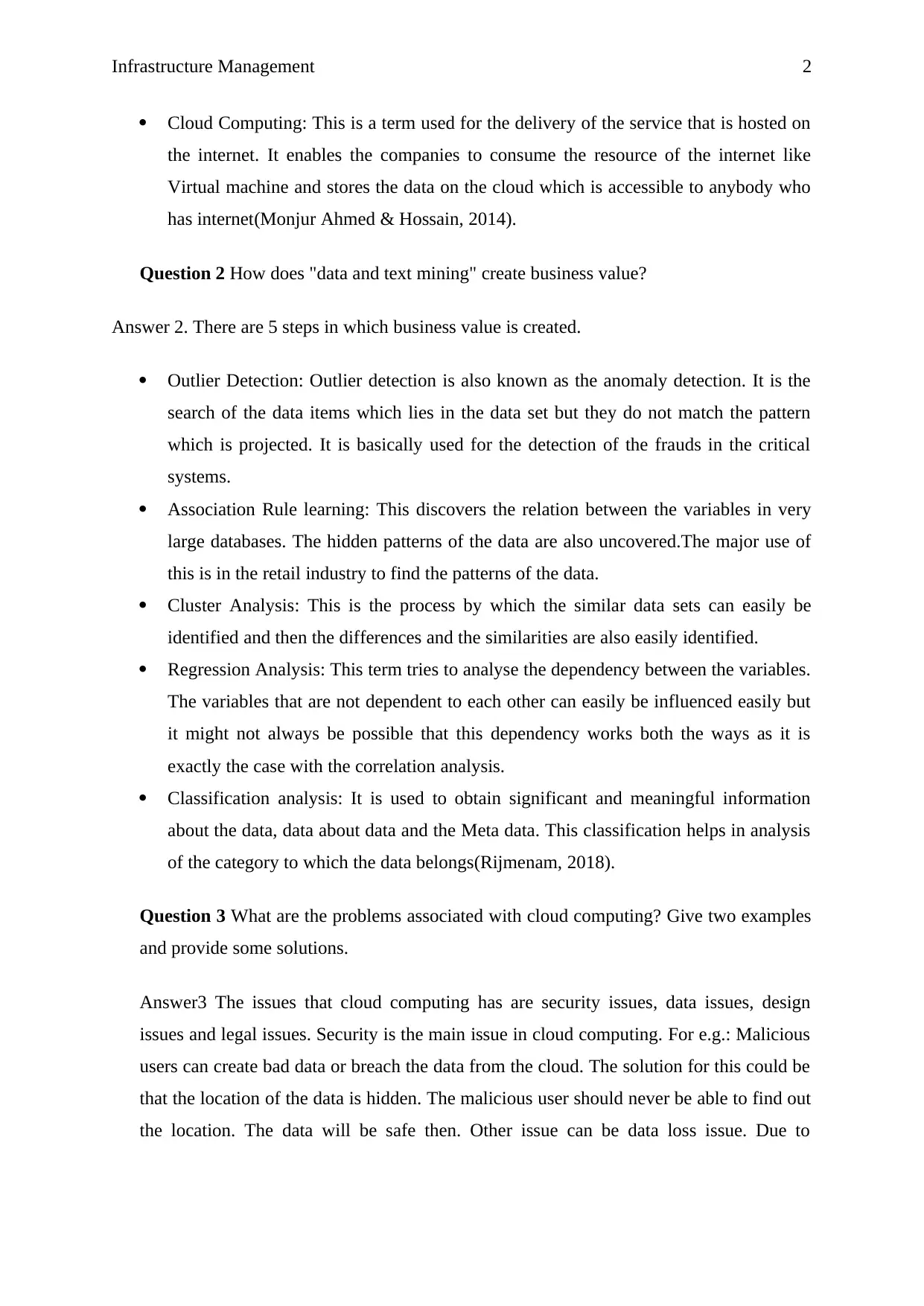
Infrastructure Management
Cloud Computing: This is a term used for the delivery of the service that is hosted on
the internet. It enables the companies to consume the resource of the internet like
Virtual machine and stores the data on the cloud which is accessible to anybody who
has internet(Monjur Ahmed & Hossain, 2014).
Question 2 How does "data and text mining" create business value?
Answer 2. There are 5 steps in which business value is created.
Outlier Detection: Outlier detection is also known as the anomaly detection. It is the
search of the data items which lies in the data set but they do not match the pattern
which is projected. It is basically used for the detection of the frauds in the critical
systems.
Association Rule learning: This discovers the relation between the variables in very
large databases. The hidden patterns of the data are also uncovered.The major use of
this is in the retail industry to find the patterns of the data.
Cluster Analysis: This is the process by which the similar data sets can easily be
identified and then the differences and the similarities are also easily identified.
Regression Analysis: This term tries to analyse the dependency between the variables.
The variables that are not dependent to each other can easily be influenced easily but
it might not always be possible that this dependency works both the ways as it is
exactly the case with the correlation analysis.
Classification analysis: It is used to obtain significant and meaningful information
about the data, data about data and the Meta data. This classification helps in analysis
of the category to which the data belongs(Rijmenam, 2018).
Question 3 What are the problems associated with cloud computing? Give two examples
and provide some solutions.
Answer3 The issues that cloud computing has are security issues, data issues, design
issues and legal issues. Security is the main issue in cloud computing. For e.g.: Malicious
users can create bad data or breach the data from the cloud. The solution for this could be
that the location of the data is hidden. The malicious user should never be able to find out
the location. The data will be safe then. Other issue can be data loss issue. Due to
2
Cloud Computing: This is a term used for the delivery of the service that is hosted on
the internet. It enables the companies to consume the resource of the internet like
Virtual machine and stores the data on the cloud which is accessible to anybody who
has internet(Monjur Ahmed & Hossain, 2014).
Question 2 How does "data and text mining" create business value?
Answer 2. There are 5 steps in which business value is created.
Outlier Detection: Outlier detection is also known as the anomaly detection. It is the
search of the data items which lies in the data set but they do not match the pattern
which is projected. It is basically used for the detection of the frauds in the critical
systems.
Association Rule learning: This discovers the relation between the variables in very
large databases. The hidden patterns of the data are also uncovered.The major use of
this is in the retail industry to find the patterns of the data.
Cluster Analysis: This is the process by which the similar data sets can easily be
identified and then the differences and the similarities are also easily identified.
Regression Analysis: This term tries to analyse the dependency between the variables.
The variables that are not dependent to each other can easily be influenced easily but
it might not always be possible that this dependency works both the ways as it is
exactly the case with the correlation analysis.
Classification analysis: It is used to obtain significant and meaningful information
about the data, data about data and the Meta data. This classification helps in analysis
of the category to which the data belongs(Rijmenam, 2018).
Question 3 What are the problems associated with cloud computing? Give two examples
and provide some solutions.
Answer3 The issues that cloud computing has are security issues, data issues, design
issues and legal issues. Security is the main issue in cloud computing. For e.g.: Malicious
users can create bad data or breach the data from the cloud. The solution for this could be
that the location of the data is hidden. The malicious user should never be able to find out
the location. The data will be safe then. Other issue can be data loss issue. Due to
2
⊘ This is a preview!⊘
Do you want full access?
Subscribe today to unlock all pages.

Trusted by 1+ million students worldwide
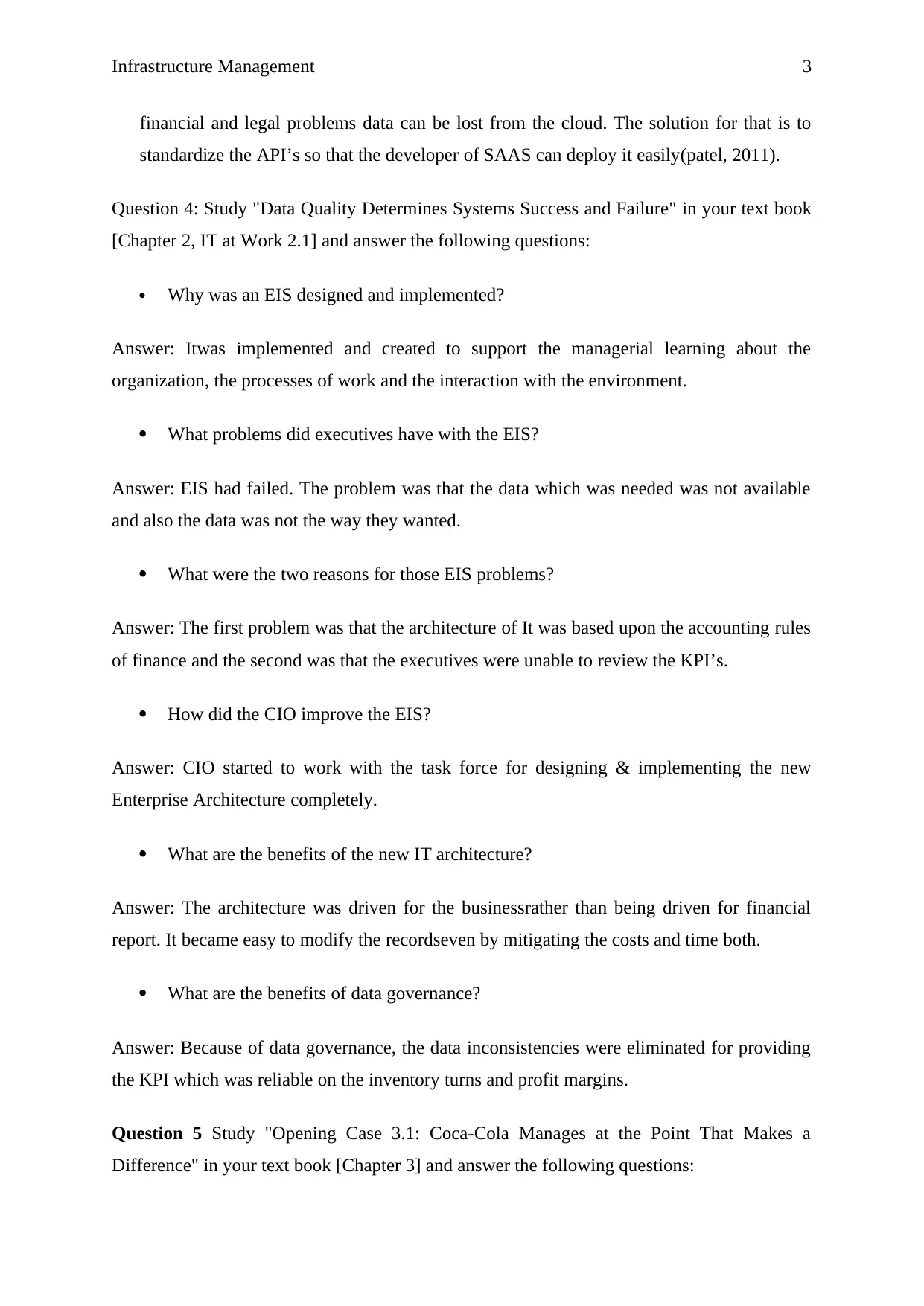
Infrastructure Management
financial and legal problems data can be lost from the cloud. The solution for that is to
standardize the API’s so that the developer of SAAS can deploy it easily(patel, 2011).
Question 4: Study "Data Quality Determines Systems Success and Failure" in your text book
[Chapter 2, IT at Work 2.1] and answer the following questions:
Why was an EIS designed and implemented?
Answer: Itwas implemented and created to support the managerial learning about the
organization, the processes of work and the interaction with the environment.
What problems did executives have with the EIS?
Answer: EIS had failed. The problem was that the data which was needed was not available
and also the data was not the way they wanted.
What were the two reasons for those EIS problems?
Answer: The first problem was that the architecture of It was based upon the accounting rules
of finance and the second was that the executives were unable to review the KPI’s.
How did the CIO improve the EIS?
Answer: CIO started to work with the task force for designing & implementing the new
Enterprise Architecture completely.
What are the benefits of the new IT architecture?
Answer: The architecture was driven for the businessrather than being driven for financial
report. It became easy to modify the recordseven by mitigating the costs and time both.
What are the benefits of data governance?
Answer: Because of data governance, the data inconsistencies were eliminated for providing
the KPI which was reliable on the inventory turns and profit margins.
Question 5 Study "Opening Case 3.1: Coca-Cola Manages at the Point That Makes a
Difference" in your text book [Chapter 3] and answer the following questions:
3
financial and legal problems data can be lost from the cloud. The solution for that is to
standardize the API’s so that the developer of SAAS can deploy it easily(patel, 2011).
Question 4: Study "Data Quality Determines Systems Success and Failure" in your text book
[Chapter 2, IT at Work 2.1] and answer the following questions:
Why was an EIS designed and implemented?
Answer: Itwas implemented and created to support the managerial learning about the
organization, the processes of work and the interaction with the environment.
What problems did executives have with the EIS?
Answer: EIS had failed. The problem was that the data which was needed was not available
and also the data was not the way they wanted.
What were the two reasons for those EIS problems?
Answer: The first problem was that the architecture of It was based upon the accounting rules
of finance and the second was that the executives were unable to review the KPI’s.
How did the CIO improve the EIS?
Answer: CIO started to work with the task force for designing & implementing the new
Enterprise Architecture completely.
What are the benefits of the new IT architecture?
Answer: The architecture was driven for the businessrather than being driven for financial
report. It became easy to modify the recordseven by mitigating the costs and time both.
What are the benefits of data governance?
Answer: Because of data governance, the data inconsistencies were eliminated for providing
the KPI which was reliable on the inventory turns and profit margins.
Question 5 Study "Opening Case 3.1: Coca-Cola Manages at the Point That Makes a
Difference" in your text book [Chapter 3] and answer the following questions:
3
Paraphrase This Document
Need a fresh take? Get an instant paraphrase of this document with our AI Paraphraser
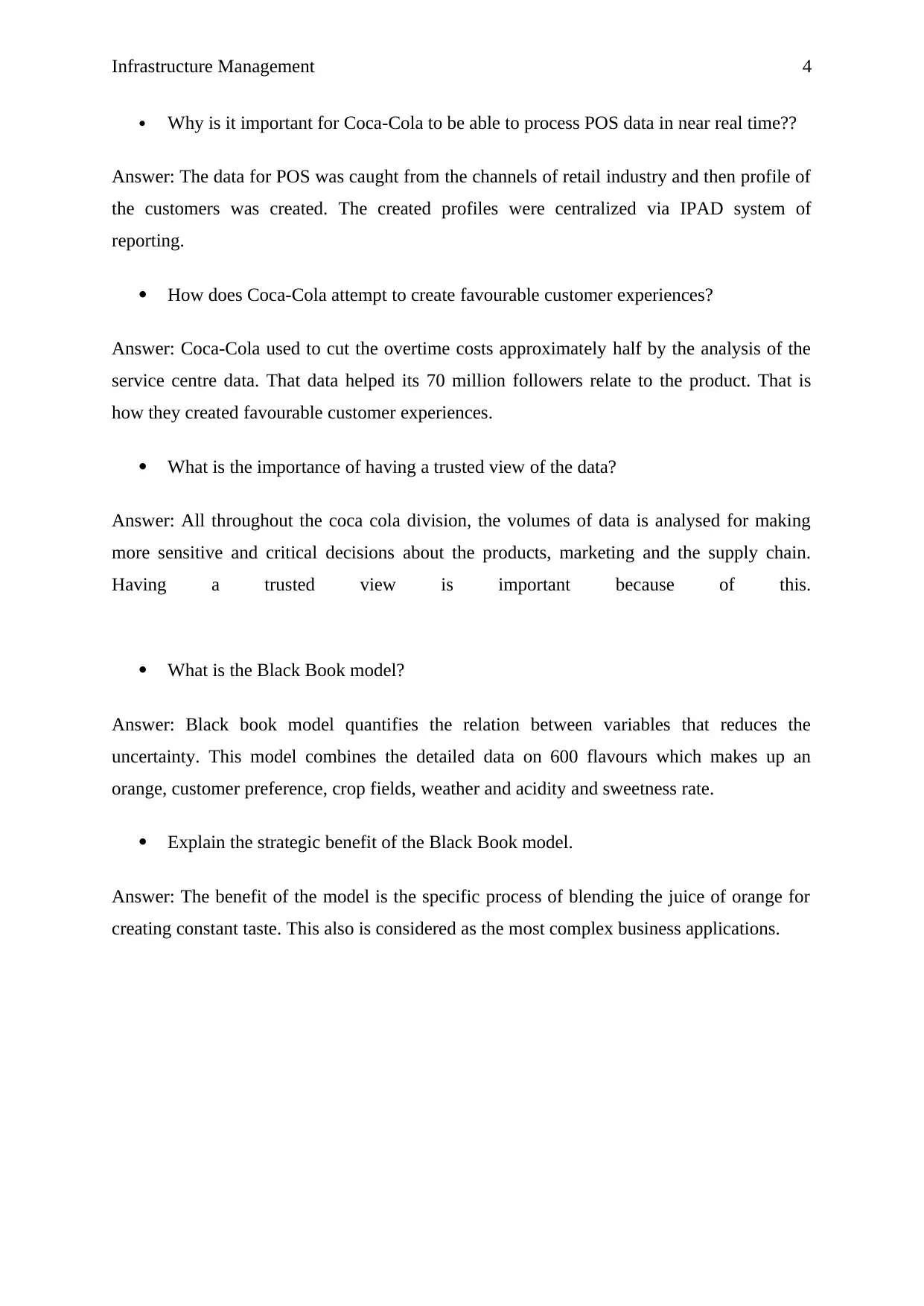
Infrastructure Management
Why is it important for Coca-Cola to be able to process POS data in near real time??
Answer: The data for POS was caught from the channels of retail industry and then profile of
the customers was created. The created profiles were centralized via IPAD system of
reporting.
How does Coca-Cola attempt to create favourable customer experiences?
Answer: Coca-Cola used to cut the overtime costs approximately half by the analysis of the
service centre data. That data helped its 70 million followers relate to the product. That is
how they created favourable customer experiences.
What is the importance of having a trusted view of the data?
Answer: All throughout the coca cola division, the volumes of data is analysed for making
more sensitive and critical decisions about the products, marketing and the supply chain.
Having a trusted view is important because of this.
What is the Black Book model?
Answer: Black book model quantifies the relation between variables that reduces the
uncertainty. This model combines the detailed data on 600 flavours which makes up an
orange, customer preference, crop fields, weather and acidity and sweetness rate.
Explain the strategic benefit of the Black Book model.
Answer: The benefit of the model is the specific process of blending the juice of orange for
creating constant taste. This also is considered as the most complex business applications.
4
Why is it important for Coca-Cola to be able to process POS data in near real time??
Answer: The data for POS was caught from the channels of retail industry and then profile of
the customers was created. The created profiles were centralized via IPAD system of
reporting.
How does Coca-Cola attempt to create favourable customer experiences?
Answer: Coca-Cola used to cut the overtime costs approximately half by the analysis of the
service centre data. That data helped its 70 million followers relate to the product. That is
how they created favourable customer experiences.
What is the importance of having a trusted view of the data?
Answer: All throughout the coca cola division, the volumes of data is analysed for making
more sensitive and critical decisions about the products, marketing and the supply chain.
Having a trusted view is important because of this.
What is the Black Book model?
Answer: Black book model quantifies the relation between variables that reduces the
uncertainty. This model combines the detailed data on 600 flavours which makes up an
orange, customer preference, crop fields, weather and acidity and sweetness rate.
Explain the strategic benefit of the Black Book model.
Answer: The benefit of the model is the specific process of blending the juice of orange for
creating constant taste. This also is considered as the most complex business applications.
4
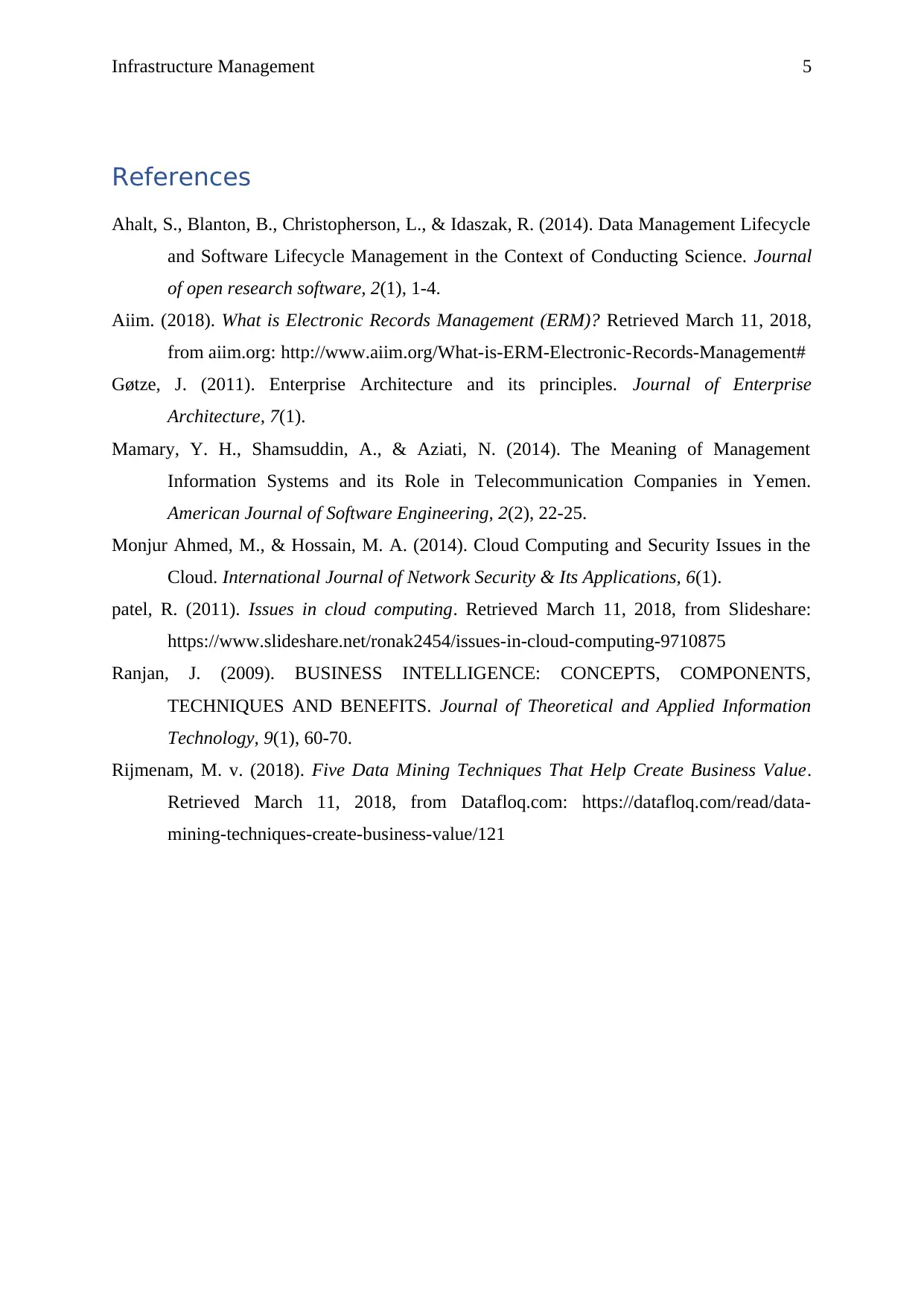
Infrastructure Management
References
Ahalt, S., Blanton, B., Christopherson, L., & Idaszak, R. (2014). Data Management Lifecycle
and Software Lifecycle Management in the Context of Conducting Science. Journal
of open research software, 2(1), 1-4.
Aiim. (2018). What is Electronic Records Management (ERM)? Retrieved March 11, 2018,
from aiim.org: http://www.aiim.org/What-is-ERM-Electronic-Records-Management#
Gøtze, J. (2011). Enterprise Architecture and its principles. Journal of Enterprise
Architecture, 7(1).
Mamary, Y. H., Shamsuddin, A., & Aziati, N. (2014). The Meaning of Management
Information Systems and its Role in Telecommunication Companies in Yemen.
American Journal of Software Engineering, 2(2), 22-25.
Monjur Ahmed, M., & Hossain, M. A. (2014). Cloud Computing and Security Issues in the
Cloud. International Journal of Network Security & Its Applications, 6(1).
patel, R. (2011). Issues in cloud computing. Retrieved March 11, 2018, from Slideshare:
https://www.slideshare.net/ronak2454/issues-in-cloud-computing-9710875
Ranjan, J. (2009). BUSINESS INTELLIGENCE: CONCEPTS, COMPONENTS,
TECHNIQUES AND BENEFITS. Journal of Theoretical and Applied Information
Technology, 9(1), 60-70.
Rijmenam, M. v. (2018). Five Data Mining Techniques That Help Create Business Value.
Retrieved March 11, 2018, from Datafloq.com: https://datafloq.com/read/data-
mining-techniques-create-business-value/121
5
References
Ahalt, S., Blanton, B., Christopherson, L., & Idaszak, R. (2014). Data Management Lifecycle
and Software Lifecycle Management in the Context of Conducting Science. Journal
of open research software, 2(1), 1-4.
Aiim. (2018). What is Electronic Records Management (ERM)? Retrieved March 11, 2018,
from aiim.org: http://www.aiim.org/What-is-ERM-Electronic-Records-Management#
Gøtze, J. (2011). Enterprise Architecture and its principles. Journal of Enterprise
Architecture, 7(1).
Mamary, Y. H., Shamsuddin, A., & Aziati, N. (2014). The Meaning of Management
Information Systems and its Role in Telecommunication Companies in Yemen.
American Journal of Software Engineering, 2(2), 22-25.
Monjur Ahmed, M., & Hossain, M. A. (2014). Cloud Computing and Security Issues in the
Cloud. International Journal of Network Security & Its Applications, 6(1).
patel, R. (2011). Issues in cloud computing. Retrieved March 11, 2018, from Slideshare:
https://www.slideshare.net/ronak2454/issues-in-cloud-computing-9710875
Ranjan, J. (2009). BUSINESS INTELLIGENCE: CONCEPTS, COMPONENTS,
TECHNIQUES AND BENEFITS. Journal of Theoretical and Applied Information
Technology, 9(1), 60-70.
Rijmenam, M. v. (2018). Five Data Mining Techniques That Help Create Business Value.
Retrieved March 11, 2018, from Datafloq.com: https://datafloq.com/read/data-
mining-techniques-create-business-value/121
5
⊘ This is a preview!⊘
Do you want full access?
Subscribe today to unlock all pages.

Trusted by 1+ million students worldwide
1 out of 6
Related Documents
Your All-in-One AI-Powered Toolkit for Academic Success.
+13062052269
info@desklib.com
Available 24*7 on WhatsApp / Email
![[object Object]](/_next/static/media/star-bottom.7253800d.svg)
Unlock your academic potential
Copyright © 2020–2025 A2Z Services. All Rights Reserved. Developed and managed by ZUCOL.


